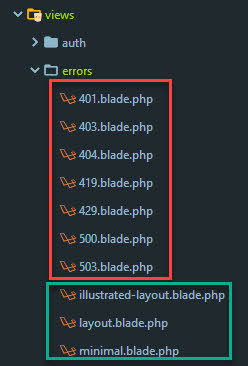Error pages
- Out of the box Laravel supports all most common error pages:
- 401: Unauthorized and 403: Forbidden
(What's the difference between 401 and 403?) - 404: Not Found
- 419: Page Expired
- 429: Too Many Requests
- 500: Server Error
- 503: Service Unavailable
- 401: Unauthorized and 403: Forbidden
Localization
- It is very easy to change the language of the error messages: Config -> Localization
Custom error pages
- If you are satisfied with the (standard) layout of the error pages, you don't have to change anything
- Maybe you want the pages in the same layout as the rest of the site
- This can be done manually (see Laravel -> Custom error pages) or by publishing (= copying) all error pages from the framework to the website and then adjusting them to your own wishes
- Publish all error pages to the website:
php artisan vendor:publish --tag laravel-errors

- The first seven pages inside resources/views/errors/ are the error pages
- The last three pages are Blade templates (only the last one, minimal.blade.php will be used at the moment)
- First take a closer look at the code of 404.blade.php and 403.blade.php
// 404.blade.php
@extends('errors.minimal')
@section('title', __('Not Found'))
@section('code', '404')
@section('message', __('Not Found'))
1
2
3
4
5
2
3
4
5
// 403.blade.php
@extends('errors.minimal')
@section('title', __('Forbidden'))
@section('code', '403')
@section('message', __($exception->getMessage() ?: 'Forbidden'))
1
2
3
4
5
2
3
4
5
- Laravel uses a special helper function
__()to translate the error messages:- 404.blade.php:
__('Not Found')refers to the string"Not Found": "Pagina niet gevonden",in resources/lang/nl.json - 403.blade.php:
__($exception->getMessage() ?: 'Forbidden')first checks if the exception contains a custom error message. If there is no custom message, the string"Forbidden": "Verboden",in resources/lang/nl.json will be used
- 404.blade.php:
- In order to give these error pages the same layout as the rest of the site, you have to point
@extendsto your own Blade template and put the other content in the appropriate section(s) of that template
Trigger an error (abort)
- To test the exception, you're now going to simulate a 404 and a 403 error
- Open routes/web.php and add a new route
// routes/web.php
Route::get('mySillyPage', function () {
// abort with error 404
return abort('404');
// abort with error 403 (default error message)
// return abort('403');
// abort with error 403 (custom error message)
// return abort('403', 'My Silly Error');
});
1
2
3
4
5
6
7
8
9
2
3
4
5
6
7
8
9
return abort('404');aborts the rest of the code and sends you to the 404 pagereturn abort('403');aborts the rest of the code and sends you to the 403 page, with the default error messagereturn abort('403', 'My Silly Error');aborts the rest of the code and sends you to the 403 page, with a custom error message
